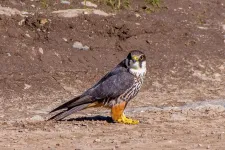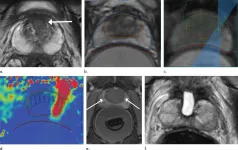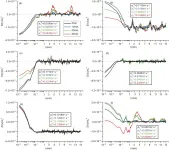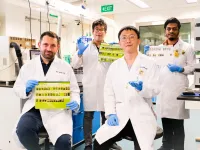(Press-News.org) CORVALLIS, Ore. - One of birdwatching's most commonly held and colorfully named beliefs, the Patagonia Picnic Table Effect, is more a fun myth than a true phenomenon, Oregon State University research suggests.
Owing its moniker to an Arizona rest area, the Patagonia Picnic Table Effect, often shortened to PPTE, has for decades been cited as a key driver of behavior, and rare-species-finding success, among participants in the multibillion-dollar recreational birding business - an industry that has gotten even stronger during a pandemic that's shut down so many other activities.
But a study led by an OSU College of Science graduate student shows that the PPTE - which says that after a rare bird is spotted somewhere, birders flock to the area and then find additional rare species at an accelerated rate - is not borne out by the data.
Findings were published in PeerJ.
"Birdwatching is one of the fastest growing recreational activities in the world," said OSU integrative biology Ph.D. student Jesse Laney. "The lure of finding very rare birds adds a level of excitement that draws birders even from distant locations."
The specifics of the Patagonia Picnic Table Effect's origin story have grown slightly murky over time, but its basic gist is engrained in birder lore.
Patagonia is a tiny town near the Arizona-Mexico border, and a nearby rest area gave rise to the picnic table part of the name. Sometime in the 1960s or 1970s, birders saw a rare black-capped gnatcatcher, or possibly a nesting pair of rose-throated becards, at the rest area.
Whichever it was, or whether it was something else entirely, word began to spread and birders began descending on Patagonia, which led to other interesting sightings, among them the thick-billed kingbird, five-striped sparrow and yellow grosbeak. The rest area remains a pilgrimage location for birdwatchers.
"It is anecdotal that when rare species are reported, increased activity by birders attempting to add rarities to their personal lists leads to the discovery of additional rare birds," Laney said. "The U.S. birdwatching community has been a big subscriber to the Patagonia Picnic Table Effect - it's something they really believe in."
Laney and collaborators in the OSU College of Agricultural Sciences and at Cornell University examined the PPTE's veracity by analyzing a decade's worth of information in eBird, an online, public bird observation database maintained by Cornell.
"We wanted to know how often a discovery of one rare bird draws so many birders to a place that even more rarities are discovered?" Laney said. "We found that birders had no better chance of finding additional rarities at locations where a rare species had been discovered than they did when searching elsewhere for rare species. In a nutshell we found little support for the Patagonia Picnic Table Effect and therefore have to consider it a myth - while acknowledging that it is a really fun myth."
Laney and collaborators Tyler Hallman and W. Douglas Robinson of the College of Agricultural Sciences and OSU alumna Jenna Curtis, now a staff member at Cornell, focused on sightings of North American "mega-rarities," 81 of the hardest-to-spot bird species on the continent - all were rated as 4 or 5 on the American Birding Association's five-point rarity scale.
The scientists looked at 273 mega-rarity discoveries involving those 81 birds over 10 years starting in 2008, and the ensuing "draw and decay" - birders descending on an area following a sighting, and then the tapering off of birding activity after the draw peaks. The mega-rarity events included a northern lapwing in Maine in 2013, a Eurasian hobby on Washington's Olympic Peninsula in 2014, and a streak-backed oriole at Carlsbad Caverns National Park in 2015.
"Across those 273 mega-rarity events, eBird data show that birder effort increased above the pre-event baseline level," Laney said. "The power of rare species to draw attention of birders was influenced by locational factors such as latitude and proximity to an airport, and by the year in which events took place."
The speed with which birders lost interest in seeking each rarity - the decay rate - was influenced by how long those rare birds continued to be detected, he added.
"Still, the decay rate was pretty variable among those events," Laney said. "We found no indication that draw was influenced by species identity or rarity level. To us, this suggests that mega-rarities have a profound influence on the behavior of birders simply by virtue of being very rare."
INFORMATION:
Supporting this research were the ARCS Foundation (Achievement Rewards for College Scientists) and the Bob and Phyllis Mace Watchable Wildlife Professorship.
Scientists and engineers at the University of Sydney and Microsoft Corporation have opened the next chapter in quantum technology with the invention of a single chip that can generate control signals for thousands of qubits, the building blocks of quantum computers.
"To realise the potential of quantum computing, machines will need to operate thousands if not millions of qubits," said Professor David Reilly, a designer of the chip who holds a joint position with Microsoft and the University of Sydney.
"The world's biggest quantum computers currently operate with just 50 or so qubits," he said. "This small scale is partly because of limits to the physical architecture that control the qubits."
"Our ...
New research from the Okinawa Institute of Science and Technology Graduate University (OIST) has found a surprising randomness for how fluids choose their path around obstacles that depends on their spacing. This has important implications for a range of scenarios - from oil recovery and groundwater remediation, to understanding the movement of fluids through biological systems. The research was published in Physical Review Letters.
Scientists from OIST's Micro/Bio/Nanofluidics Unit created a tiny set up comprised of two microscopic cylinders, each around the width of a human hair, placed side-by-side in a channel. This created a choice of three possible paths for a fluid to take past the pair of obstacles. A viscoelastic fluid, which is like that ...
OAK BROOK, Ill. - A technique that delivers high-intensity focused ultrasound to targeted tissue under MRI guidance effectively treats intermediate-risk prostate cancer with minimal side effects, according to a study published in Radiology.
Prostate cancer is the most common cancer among men, aside from non-melanoma skin cancers. Common treatments to the entire gland, such as surgery and radiation therapy, are effective in eliminating the cancer, but they often leave patients with incontinence and sexual dysfunction.
A class of treatments called focal therapy offers an alternative for some men with intermediate-risk disease that is still confined to the prostate. In focal therapy, the cancer is ablated, or destroyed, by either ...
By late summer 2020, the resurgence of COVID-19 in the United States was largely driven by adults between the ages of 20 and 49, a new study finds. The results indicate that in locations where novel highly transmissible SARS-CoV-2 lineages have not yet established, additional interventions among adults of these ages could bring resurgent COVID-19 epidemics under control and avert deaths. Following initial declines in the number of reported SARS-CoV-2 infections and deaths - a result largely attributed to non-pharmaceutical interventions - a resurgence in transmission of COVID-19 occurred in the United States and Europe beginning in August 2020. Understanding the age demographics that drove this is crucial. For example, between August ...
Laser particles are micrometre and nanometre lasers in the form of particles dispersible in aqueous solution, which have attracted considerable interest in the life sciences as a promising new optical probe. Laser particles emit highly bright light with extremely narrow spectral bandwidth. By transferring laser particles into live cells as shown in Figure 1, individual cells in a heterogeneous population can be tracked using each intracellular particle's specific spectral fingerprint as an optically readable barcode. However, laser particles emit directional light (Figure 2) and freely tumble inside living cells, their orientation varying randomly over time. Therefore optical readout of these labels results ...
Loess Plateau possesses a particular loess physiognomy with numerous ravines and slopes, and tableland is a typical landform in it. Together, the ununiform in both topographic undulation and land coverage compose the ununiform, complex underlying surface on Loess Plateau. This provides a special platform for research of turbulence above the complex underlying surface.
As the front-edge problem encountered in the atmospheric boundary layer thesis, the turbulence research for complex underlying surface has drawn extensive attention recently. Local similarity has already proven that under certain condition, theories of turbulence based on the uniform underlying surface can also be applied to which for the ununiform underlying surface. ...
A team from Nanyang Technological University, Singapore (NTU Singapore) has developed a portable device that produces high-resolution 3D images of human skin within 10 minutes.
The team said the portable skin mapping (imaging) device could be used to assess the severity of skin conditions, such as eczema and psoriasis.
3D skin mapping could be useful to clinicians, as most equipment used to assess skin conditions only provide 2D images of the skin surface. As the device also maps out the depth of the ridges and grooves of the skin at up to 2mm, it could also help with monitoring wound healing.
The device presses a specially devised film onto the subject's skin to obtain an imprint of up to 5 by 5 centimetres, which is then ...
A satellite-based dataset generated by KAUST researchers has revealed the dynamics of dust storm formation and movements over the last decade in the Arabian Peninsula. Analysis of this long-term dataset reveals the connection between the occurrence of extreme dust events and regional atmospheric conditions, a finding that could help improve weather forecasting and air-quality models.
Dust storms occur when strong winds lift tiny particles of sand into the atmosphere. These events often span several miles and can have an enormous impact on daily life, from damaging buildings and disrupting air traffic to triggering respiratory illnesses and other health problems.
The Arabian Peninsula is a global hotspot of extreme dust events, with storms occurring ...
Residential gardens are a poor substitute for native bushland and increasing urbanisation is a growing threat when it comes to bees, Curtin University research has found.
Published in 'Urban Ecosystems', the research looked at bee visits to flowers, which form pollination networks across different native bushland and home garden habitats.
Lead author, Forrest Foundation Scholar Miss Kit Prendergast, from Curtin's School of Molecular and Life Sciences said the findings highlight the need to prevent destruction of remaining bushland and preserve native vegetation, in order to protect sustainable bee communities and their pollination services.
"Our study involved spending hundreds of hours at 14 sites on the Swan Coastal Plain at Perth, Western Australia, ...
Researchers have shown how disposable face masks could be recycled to make roads, in a circular economy solution to pandemic-generated waste.
Their study shows that using the recycled face mask material to make just one kilometre of a two-lane road would use up about 3 million masks, preventing 93 tonnes of waste from going to landfill.
Developed by researchers at RMIT University in Melbourne, Australia, the new road-making material is a mix of shredded single-use face masks and processed building rubble designed to meet civil engineering safety standards. ...





